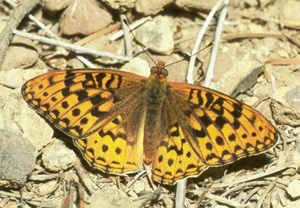Speyeria zerene hippolyta, Oregon Silverspot Butterfly |
|---|
 The Oregon Silverspot Butterfly, Speyeria zerene hippolyta, is a fritillary (subfamily Argynninae) of the Nymphalidae family, or brush-footed butterflies. The butterflies of the genus Speyeria represent the larger members of the fritillary subfamily, and all feed on violets (Viola spp.) as larvae. The Oregon Silverspot is a medium-sized butterfly having a wingspan of 3-5cm. It has a brownish-body having dark brown and orange markings on the top of its wings. The underside of the wings are orange with bright silver spots. Identification is extremely difficult as several subspecies of Speyeriazerene closely resemble one another. The diet of the larvae is restricted to a low-growing species of meadow violet, Early Blue violet (Viola adunca), which must be present in relative abundance in order for the larvae to locate and feed on the plant after over wintering. In addition, it is necessary for the habitat to provide shelter from high winds and rain while also providing an adequate nectar supply for adults Oregon Silverspot Butterflies were once a common sight along pacific coastal meadows ranging from Northern California to Southern Washington. It was federally listed as threatened in 1980 following a series of population studies by McCorkle et al. That same year it was listed by Washington State as endangered, and by Oregon State as threatened. Since its listing extensive population surveys have been conducted for specific populations that were once known to be present in an effort to assess the health and size of present populations. It was found in 1982 that the species was restricted to six small pockets scattered along the pacific coast, and that many populations in Oregon, and possibly all of Washington's populations had been extirpated. Development and Control of coastal property are contributing to a decrease in the abundance of the food plant of this species and appear to be the biggest threat. Viola adunca relies on regular brush fires, salt spray, and wind to control other plants competing for light and space. Fire control, non-native plants, and development of coastal property are decreasing violet abundance and threatening Silverspot survival by increasing larval mortality rates. Other contributing factors to Silverspot mortality include the use of non-specific pesticides in homes, coastal highway development, and loss of genetic diversity. Genetic diversity is an especially concerning issue because still-existing populations are small and far apart from one another. This makes it extremely difficult to increase genetic diversity in already lacking populations. These threats apply to other members of the genus that share similar vulnerabilities. Of the five western-occurring Speyeria zerene species, two others, Speyeria zerene behrensii, and Speyeria zerene myrtleae are listed as endangered and are now restricted entirely to small Northern California coastal regions. The most important step being taken towards saving this species is habitat conservation. By listing the species as threatened, existing populations and their habitats are protected at seven different locations. Support from the Nature Conservancy and U.S. Fish and Wildlife is restoring damaged habitat through controlled burning and management. In addition, the locations of once-existing populations are being restored in Washington in hopes of reintroducing the species. A 1999 revision of the Oregon Silverspot recovery plan has allowed two zoos to captive-rear individuals in a protected environment for later release in hopes of decreasing larval mortality rates. |
Resources:
|
Written by: Ariel Zimmerman 2004 Updated: Eric Denemark 2008 |
Image credit: Richard Arnold |